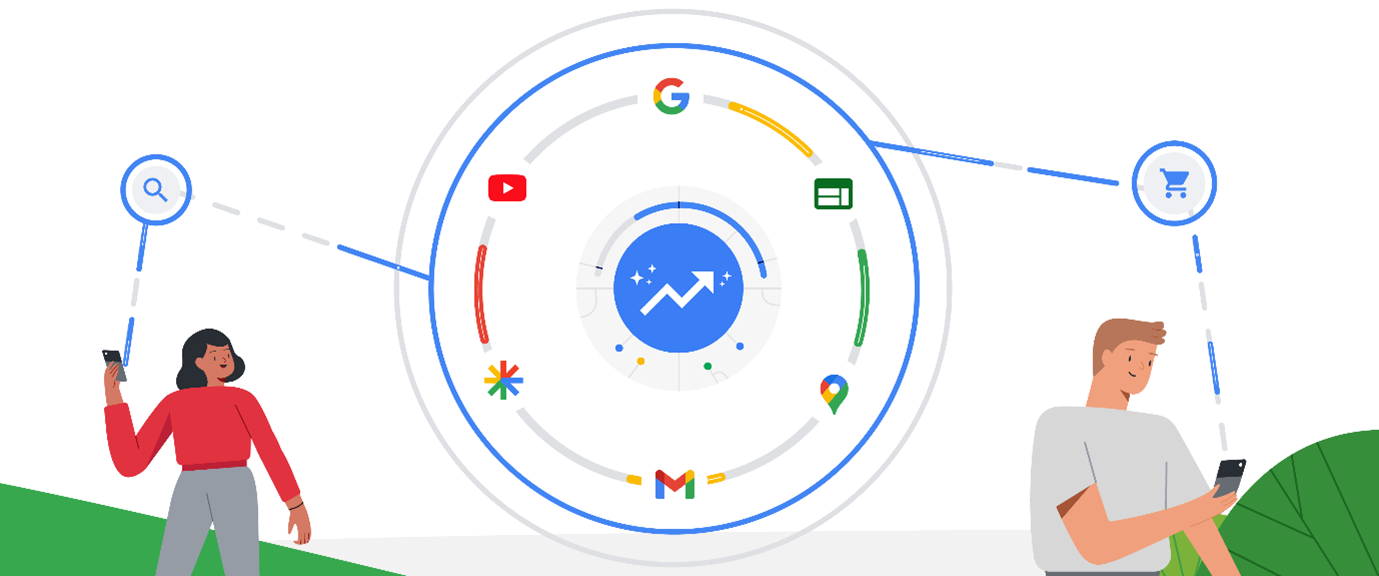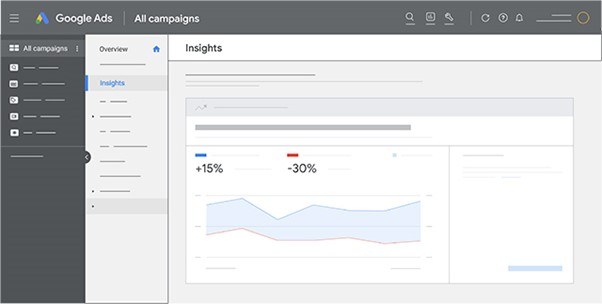In July 2022, all smart shopping campaigns started to automatically migrate to Performance Max and we found ourselves forced to manage fully automated campaigns with only top-level statistics. However, Performance Max campaigns new method of setting up asset groups can be efficient, and therefore allow improved creativity to 'soften the blow' of the less versatile segmentation.
If you already have Google Ads shopping campaigns and want to use Google’s automation to advertise products from an ecommerce store on Google Shopping, you are probably already aware of Google Performance Max campaigns.
In addition, if your aim is to approach the customer in multiple touchpoints during their online journey, but you don’t want to spend time managing multiple campaigns across all Google channels, you will surely have read about Performance Max when searching for information over the web.
In the article below, we look at some of the key features of Performance Max and what to expect.

What expectations should be set?
Performance Max is still relatively new for many PPC practitioners and nobody knows what to expect from the campaigns performance. This is because there’s not a lot of information out there. Most marketers who have been running Performance Max campaigns are still trying to find best practices and ways of optimising the campaigns efficiently.
The biggest challenge is that the Performance Max campaigns are a “black box” (although a few improvements are starting to appear). This means that it’s not possible to get deep insights regarding audience, keywords or ads performance in the Google Ads interface, making it harder to predict or to optimise the performance towards the KPIs.
Also, account owners frequently demand performance projections in order to have an accurate feeling of what to expect in regard to the campaign results. But with Performance Max’s lack of information, this task can be really difficult to achieve.
During our testing on Performance Max campaigns, we found two things that will help:
- Ad spend will gradually increase in a Performance Max campaign. So, allow 3 -5 days for the campaign ad spend to build up and get close to the daily budget
- It’s likely that a Performance Max campaign won’t deliver the strongest performance within the first 7-10 days. Therefore it’s important to give the Performance Max campaigns at least 2-3 weeks before starting seeing the “real results”
It’s also true that a Performance Max campaign can drive strong results. However, with little performance information, it can be tricky to improve cost-efficiency manually. But, because the algorithm within a Performance Max campaign can deal with multiple signals in order to optimise the performance, not having access to data analysis does not necessarily mean that the campaign will underperform. In fact, it's exactly the opposite; the more signals the Performance Max campaign has, the more efficiently the algorithm will work.
What is a recommended Performance Max campaign structure?
A Performance Max campaign structure can be a little confusing to set up. The secret is to structure the campaign in niched asset groups, driving relevant messages to the specific audiences. But what are asset groups?
Asset groups are what PPC managers used to call “ad groups” in a standard search or shopping campaign. The biggest difference is within the assets (ads) and audience set up. Whilst in standard search or shopping campaign, search keywords or product feed information are used to target the audience, Performance Max will use audience signals, which means that the given audience set up will work as parameters for the algorithm to expand the audience reach.
It's similar to how Google works with similar audiences, where the algorithm uses the 1st party data to expand the audience reach.
Let’s take one example; an online store wants to advertise a 15” laptop from a popular brand and would like to reach the potential buyer during his online journey through different channels by using a Performance Max campaign.
When setting up the asset group, it’s recommended providing all the audience signals available, like 1st party data (i.e. Past purchasers, Visitors Last 90 days, Multiple items purchasers, etc) + search intent custom segment (i.e. laptop 15”, purchase laptop, buy brand laptop online, etc) + Interests and Demographics audiences (i.e. Laptop Computers, Laptops, Windows 10 laptops, etc).
A huge positive is that Google have improved the Interest and Demographic audience signals in a Performance Max campaign, to the extent that even brand related audiences can now be found.
Cannibalisation x Incrementality: how does P-Max behave if running alongside other channels' campaigns?
There are a lot of discussions around if Performance Max increments or cannibalises traffic from other channels’ campaigns, if these campaigns are running simultaneously. Some marketers will notice Performance Max campaigns taking over traffic from other channels’ campaigns, others will conclude that they have achieved success with running Performance Max alongside other standard campaigns in Google Ads.
But which of these is really true?
Google Ads Help centre states the following (About Performance Max campaigns):
“Performance Max complements existing Search campaigns and respects your keyword targeting. If the user’s query is identical to an eligible Search keyword of any match type in your account, the Search campaign will be prioritized over Performance Max. If the query is not identical to an eligible Search keyword, the campaign or ad with the highest Ad Rank, which considers creative relevance and performance, will be selected.”
This means that Google will prioritise serving ads from a search campaign if the user’s query is identical, regardless of which campaign has the highest Ad Rank. That said, it’s unlikely that the Performance Max campaigns will cannibalise the traffic from the search campaign.
Some could argue that they have seen Performance Max cannibalising traffic from their search campaigns. However, due to the lack of data available for analysis in a Performance Max campaign, there’s no clear evidence to back this up.
Reports: Are there any?

This is the biggest downside of using Performance Max because very little data is available for analysis, making it harder to provide insights, reports and even come up with an optimisation plan. However, there is a degree of information that can be extracted from a Performance Max campaign, and the Insights tab will become every digital marketers best friend.
Google has made some really useful changes to the Insights tab, one of which is the search terms categories report. In the search terms categories, Google groups trigger search terms in themes, and provides metric performance (Conversions, Clicks, Impressions, Conv. value, CTR and Conv. rate) and search volume* from top-performing themes.

With this information, marketers will be able to understand changes in the keyword categories performance, such as when less conversions are delivered from the brand search terms groups vs non-brand.
The Insights tab also provides information about top-performing audience segments, which helps us to understand who is engaging with the campaign. This works in a pretty similar way to the search terms themes report.
This data is very helpful to optimise audience signals within the asset groups. One idea, for example, is to push audience segments with strong performance to a new asset group, coupled with a more bespoke message.
In terms of reporting, in the Reports menu, there’s a predefined report under Others that is called Performance Max campaigns placement. This report offers insights about the placements performance, opening the opportunity to escalate more asset groups and provide the Performance Max campaigns with even more audience signals.

*It's important to bear in mind that the search volume includes searches across all countries within the Google Ads account in case the campaigns are running across multiple countries.
Updates planned for the near future?
Google has announced additional features coming to the Performance campaigns, like seasonality adjustments, optimization scores, data exclusions, and new explanations.
The seasonality adjustments help optimising bids for upcoming sales events & promotions. Keep in mind that it’s not recommended to use this feature to optimise bids towards peak periods, as Google states that “Smart Bidding already manages seasonal events."
Seasonality adjustments should be used only for short periods and events, such as a week-long promotion or sale.
Optimisation score is a known feature from Google Ads and it’s now fully available in Performance Max campaigns. Similar to what it does for other campaign types, optimisation score will help with recommendations in areas with opportunity to grow, such as applying ROAS target or optimising for new customers acquisition.
Data exclusions is the feature that most digital advertisers are looking for, but you won't be able to add negative search terms or placements. Instead, data exclusions will make it possible to tell the Smart bidding to ignore data from dates where the campaign encountered issues with tagging issues or website outages, helping with the accuracy of conversions or conversion value performance.
Explanations are great to give insights regarding changes in the campaigns’ performance. Also, alongside with explanations, Google Ads can sometimes provide recommendations to help improve the performance.
In summary, “while explanations tell you why your ad performance fluctuated, recommendations help you improve your ad performance moving forward.” (Google Ads Help).
Explanations will be very helpful to understand fluctuations in performance from specific areas, like top-moving products, listing groups and product types.
Conclusion
Don’t be afraid of starting a Performance Max campaign or to migrate your smart shopping. If accurate audience signals are provided and the right asset messages are shared (with relevant images and videos), the P-Max campaign can deliver a greater volume of conversions and/or generate higher conversion value than you've experienced before.
Your creativity will become key to approach the audience with customised ads. And, the more audience signals are provided to the campaign, the more data Google machine learning will have towards optimising the ads delivery in relation to your campaign goals.
If you've got any concerns about building or optimising a Performance Max campaign, get in touch with our team of experts and have a chat!




